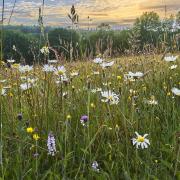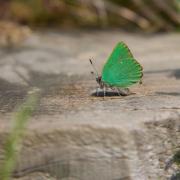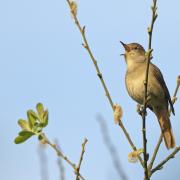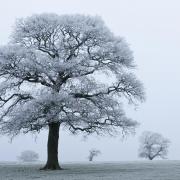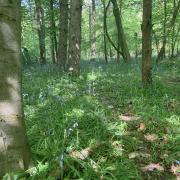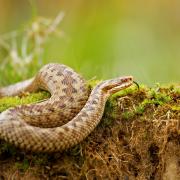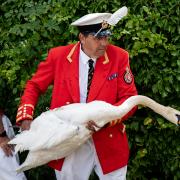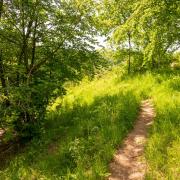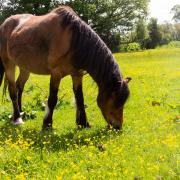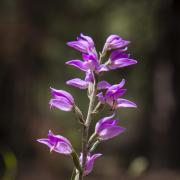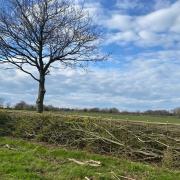December can be cold but it’s also a great month for enjoying walks on crisp frosty days and watching the birds that visit the garden, says Sue Bradley

Chalford Vale has a strong industrial heritage but is also an increasingly significant area for wildlife. It's home to both a river and the Thames and Severn Canal, both of which attract kingfisher, heron, otter and water vole, along with moor hen and coot.
Trees abound on the southern slope of the valley, while at Old Neighbourhood they grow on both sides of the railway track to form a leafy tunnel. Open fields separate the vale from Chalford Hill, while footpaths and alleys meandering between stone cottages are little changed from the days when donkeys carried bales of wool to be woven into cloth.
People living here often see deer, fox, badger, frog, toad and various birds and bats, along with butterflies and many different insects.

Recently Gloucestershire Wildlife Trust took on a new site within the Chalford Vale that for years had represented the missing piece within the area's connectivity jigsaw.
Dimmel's Dale was acquired in February following a successful fundraising appeal, helped in no small part by a donation left in memory of long-serving volunteer David Harman, by his wife Jane Ford.
The 8.5 acre site is a sweeping bank of wildflower-rich limestone grassland, with semi-natural ancient woodland and a brook. Work to put it on the path to recovery began with the removal of brambles to encourage wildflowers such as common spotted orchid, bugle, betony and marjoram to flourish and the erection of fencing to contain Welsh mountain ponies, a hardy breed well-suited to grazing grass that farmers would consider to be poor quality.

A natural shelter against the wind, rain and sun has been built, access to drinking water improved and existing tracks re-profiled. During the summer volunteers and contractors made a new stock pen and run to make it easier to get livestock on and off the nature reserve.
This winter the team will be working to cut back scrub regrowth and create 'scallops' along the woodland edge to reduce the harsh boundary between trees and grassland and create more microhabitats.
A new interpretation board means visitors can learn more about the wildlife at Dimmel's Dale, while David Harman's memory is marked by a memorial bench and remodelled shed for volunteers, which has been named 'David's Shed'.

Gloucestershire Wildlife Trust has been working hard in the Chalford Valley for several years, managing four nature reserves, including Daneway Banks and Siccaridge Wood, and supporting sympathetic landowners elsewhere.
"Most of the valley was already being managed for wildlife," explains Stroud Valleys Reserve Manager Alan Sumnall. "Through securing Dimmel's Dale we can enhance our connectivity projects through the valley, linking areas of ancient woodland and restoring the species-rich grassland. This will allow associated species, including threatened butterflies such as large blue and marsh fritillary, and woodland species such as the hazel dormouse to disperse and build larger populations more resilient to future challenges."

DID YOU KNOW?
Kissing under the mistletoe may be a long-standing Christmas tradition, but this plant is also a source of food for species such as mistle thrush and blackcaps, along with the mistletoe marble moth Celypha woodiana and the bug Anthocoris visci.
COTSWOLD GREATS
Liquorice Piercer Moth
Wild liquorice is a member of the pea family, with creamy white or slightly green tubular flowers and leaves that look similar to vetch. It's a sprawling plant that only grows in certain places, such as chalk or limestone grasslands, like those found in the Cotswolds, along with areas of woodlands and scrub. Known scientifically as Astragalus glycyphyllos, it's certainly not to be confused with culinary liquorice Glycyrrhiza glabra, which prefers a far warmer climate. Wild liquorice flowers from June to August, after which it produces pea-like pods that represent the only food plant for a rare moth, the liquorice piercer Grapholita pallifrontana.
Blackish-brown in colour, with yellow streaks across its wings and a wingspan of 10mm to 12mm, this moth gets its name from the way its bright orange caterpillars nourish themselves by eating both pods and seeds during July and August. Look for male liquorice piercers on the wing during sunny afternoons from late May to July, when they can often be seen flying around their food plant in bushy areas.
This moth is only found in parts of the south of England, including the Cotswolds, where it's known to frequent Gloucestershire Wildlife Trust-managed nature reserves such as Daneway Banks.
THINGS TO PUT OUT FOR THE BIRDS
Fresh water - break the ice on frosty days
Wild bird seed mixes
Nuts for tits, finches, jays, nuthatches and woodpeckers
Raisins for thrushes and blackbirds
Mealworm
Suet
Sunflower seeds for goldfinches, greenfinches and tits
Nyjer seeds for finches
Homemade bird cakes created from lard, seeds, nuts and raisins




